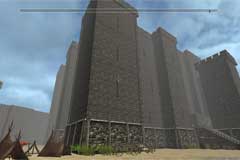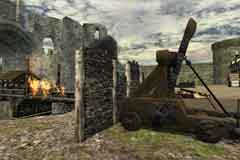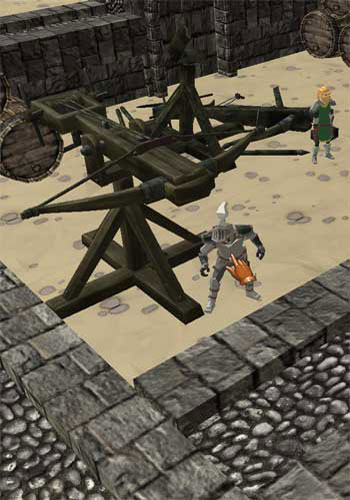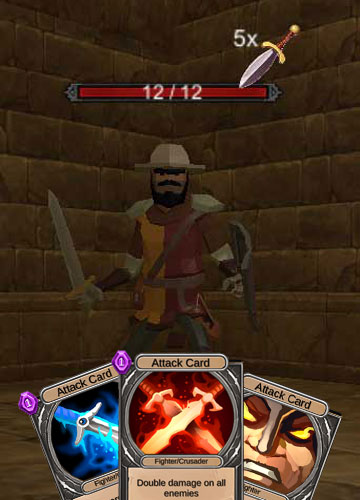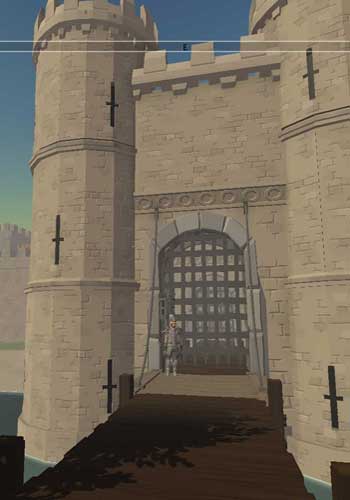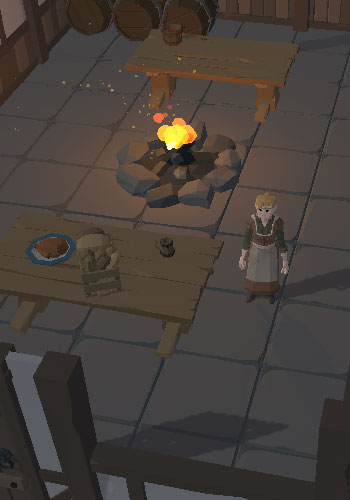Viking Invasions
Tweet
 iking invasions started in around 790 AD and in 793 the monastery at Lindisfarne was attacked, while the monastery of Iona on the west coast of Scotland was attacked in 802 AD.Churches were an easy target for the Vikings as they were built in remote locations and were poorly protected. Most importantly they contained ornaments made of silver and gold. The Vikings took everything of value, burnt the buildings and either killed the monks or took them as slaves. The number of attacks steadily grew and became an annual occurrence. At first the Vikings attacked in the summer and returned to their homelands for the winter.
iking invasions started in around 790 AD and in 793 the monastery at Lindisfarne was attacked, while the monastery of Iona on the west coast of Scotland was attacked in 802 AD.Churches were an easy target for the Vikings as they were built in remote locations and were poorly protected. Most importantly they contained ornaments made of silver and gold. The Vikings took everything of value, burnt the buildings and either killed the monks or took them as slaves. The number of attacks steadily grew and became an annual occurrence. At first the Vikings attacked in the summer and returned to their homelands for the winter.
The homeland of the Vikings was Scandinavia, the present-day countries of Denmark, Norway and Sweden. As the Vikings were pagans they did not share the same values as Christians towards churches and their inhabitants, and because these rich sources of gold and silver were often unprotected they were an easy target. The Viking invasions lasted for around 300 years and this time is also known as the Viking Age.


Based on map from Atlas of British History, G.S.P. Freeman-Grenville
 he years after 835 saw a change in Viking tactics. Much larger numbers of Viking ships and men started arriving on Britain's shores and soon the Vikings began to set-up permanent camps and stay in Britain over the winter months. In 844 the king of Northumbria was killed while defending his homeland against the invaders and in 865 the 'Great Army' landed in East Anglia, establishing a permanent foothold in Britain. The Anglo-Saxons on the east of the country were not strong enough to evict the invaders and within ten years the Vikings had control of East Anglia, the east of Mercia and parts of southern Northumbria. In Wessex, Alfred the Great, was an Anglo-Saxon ruler who was able to resist the Viking advances.
he years after 835 saw a change in Viking tactics. Much larger numbers of Viking ships and men started arriving on Britain's shores and soon the Vikings began to set-up permanent camps and stay in Britain over the winter months. In 844 the king of Northumbria was killed while defending his homeland against the invaders and in 865 the 'Great Army' landed in East Anglia, establishing a permanent foothold in Britain. The Anglo-Saxons on the east of the country were not strong enough to evict the invaders and within ten years the Vikings had control of East Anglia, the east of Mercia and parts of southern Northumbria. In Wessex, Alfred the Great, was an Anglo-Saxon ruler who was able to resist the Viking advances.
York became a centre of Viking occupation known as the kingdom of Jorvik and the wider area that the Vikings controlled was known as the Danelaw. In this area the customs of the Scandinavians were the norm. Edward the Elder, Alfred's successor, and his sister Aethelflaed, the Lady of the Mercians, were able to turn the tide of the Viking advance and win some land back from them. In 910 Edward won the important battle of Tettenhall where many Vikings were killed. Edward's success was repeated by his son Athelstan who defeated the Danes in the north and took control of Northumbria.

When the eleven year old Athelred II became the king of England in 978, the Vikings took advantage of his inability to rule the country to start raiding again. Unable to deal effectively with the invaders the English king was forced to pay the Viking money or Danegeld for them to leave. Things became so serious for Athelred that in 1013 Swein Fork-Beard and his son Canute sailed from Denmark to attack England. The Londoners defended themselves and the Vikings moved elsewhere, taking Wessex, Mercia and Northumbria. But when Athelred and his family fled from the country, Swein was chosen as the new king of England.

Swein died shortly after becoming king and Athelred was restored when Canute returned to Denmark. Athelred's reign was short and he was succeeded by his son Edmund Ironside, who unlike his father, was a fierce warrior. Edmund was able to defend England against an invasion by Canute, but after a series of inconclusive battles a peace agreement was reached whereby the county was divided between the two and when one of them should die, the other would rule the country. Edmund died shortly after the agreement and Canute became king of England.

The Scandinavian rulers controlled England until 1042 when Harthacanute died without leaving a heir and Edward the Confessor, the son of Athelred was chosen to become the new king of England. Although the Norweigian king Harald Hardrada attempted to take the English throne after the death of Edward in 1066, he failed to do so after being defeated at the battle of Stamford. This was followed by the conquest of England by William the Conqueror and the era of Viking invasions was more of less over.
 he Vinland map was found in the late 1950s and was reported to have been drawn in the late medieval period. It is supposed to show the areas visited by Europeans in the 11th century. Scientific analysis of the map and inks used are not 100% conclusive but the general opinion is that the map is a fake. Because the map was published without a copyright notice it is shown here. (Image on wikimedia)
he Vinland map was found in the late 1950s and was reported to have been drawn in the late medieval period. It is supposed to show the areas visited by Europeans in the 11th century. Scientific analysis of the map and inks used are not 100% conclusive but the general opinion is that the map is a fake. Because the map was published without a copyright notice it is shown here. (Image on wikimedia)

See the timeline below or this graphical version for more detailed information.
787
793
802
807
814
825
832
834
835
836
837
841
843
844
845
851
852
859
865
866
867
868
869
870
871
872
873
874
875
876
877
878
879
882
885
886
890
893
894
895
896
902
906
910
911
913
914
917
927
930
937
944
954
980
982
988
991
992
994
999
1001
1002
1003
1006
1008
1009
1011
1012
1013
1014
1015
1016
1017
1019
1031
1035
1037
1040
1042
1046
- Egbert (King of Wessex 802-839)
- Aethelwulf (King of Wessex 839-858)
- Aethelbert (King of Wessex 860-866)
- Aethelred (King of Wessex 866-871)
- Halfdan, (King of Danes -876)
- Aella, (King of Northumbria 866-7)
- Alfred (The Great, King of Wessex 871-899)
- Guthrum (King of the Danes -890)
- Constantine (I, Ruler of the Scots 863 - 877)
- Aed (King of Scotland 877 - 878)
- Louis (II, the Stammerer)
- Louis (III, King of France 879-882)
- Carloman (II, King of France 879-884)
- EDWARD (the Elder, King of West Saxons, 899-924)
- Rollo (Rolf or HRolf)
- Aethelflaed (Lady of the Mercians)
- ATHELSTAN (King of the English 924-939)
- Constantine (II, King of the Scottish 900-942)
- Sihtric (Norse King of York)
- Edmund (I, King of the English 939-946)
- Eadred (King of the English 946-955)
- Aethelred (II The Unready, King of the English 978-1013, 1014-1016)
- Trygvasson, Olaf
- Swein (Fork-Beard)
- Aelfheah (Archbishop of Canterbury)
- Canute (King of England 1016-1035)
- Edward (The Confessor, King of England 1042-1066)
- Emma (of Normandy, Wife of Aethelred)
- Alfred (Aetheling)
- Edmund (II Ironside, King of the English 1016)
- Harthacnut (King of England 1040-1042)
- Harold (Harefoot, King of England 1037-1040)
- Leofric (Earl of Mercia)
- Godwin (Earl of Wessex)
- Aelfgifu (of Northampton)
- Magnus (I, King of Norway)
- Whitby Abbey
- Nottingham Castle
- Peterborough Cathedral
- Crowland Abbey
- Tamworth Castle
- Stafford Castle
- Warwick Castle
- St. Albans Cathedral
- Glastonbury Abbey
- Winchester Cathedral
- Durham Cathedral
- Wallingford Castle
- Canterbury Cathedral
- London Bridge
- Wessex
- Rouen
- Plymouth
- Mercia
- York
- Danegeld
- Dublin
- London
- Danelaw
- Boulogne
- Worcester
- Normandy
- Isle of Wight
Selection of references used:
- 1: Sidney Painter, A History of the Middle Ages, 1970
- 2: G.A.Cambell, The Knights Templar. Their rise and fall
- 3: John Haywood, Encyclopaedia of the Viking Age
- 4: Richard Humble, The Fall of Saxon England
- 5: Richard Fletcher, Who's Who in Roman and Anglo-Saxon England, ISBN:0-85683-114-X
- 6: Ronald McNair Scott, Alfred the Great, ISBN:0-86332-832-6
- 7: Roy Midmer, English Medieaval Monasteries 1066-1540, 1979
- 8: Richard Cavendish, Kings and Queens The Concise Guide, ISBN:978-0-7153-2376-2
- 9: J. Raine, Historic Towns: York
- 10: C.W.Previte-Orton, The shorter Cambridge Medieval History
- 11: Magnus Magnusson, Vikings!
- 12: R. W. Chambers, M.A., D.Lit., England Before the Norman Conquest, 1926, Longmans , Green and Co. Ltd (1926)
- 13: T. Francis Bumpus, The Cathedrals of England and Wales, 1934
- 14: Peter Potter, Data Donation
- 15: John Timbs & Alexander Gunn, Abbeys, Castles and Ancient Halls of England & Wales (North), 1872, Frederick Warne & Co. (1872), Mine
- 16: Timbs & Gunn, Abbeys, Castles & Ancient Halls of England & Wales, Warne, Own Copy
- 17: Unknown, A topographical and historical account of Norwich, 1819
- 18: John E.N. Hearsey, Bridge, Church and Palace In Old London, 1961, William Clowes and Sons Limited (1961), Own copy
- 19: Frank Barlow, Edward the Confessor
- 20: Paul de Rapin-Thoyras, The History of England, Volume 5
Medieval Episodes
Early Middle Ages
High Middle Ages
- Edward the Confessor and Godwine
- Reasons for the Norman Invasion
- The Norman Invasion
- The Norman Conquest
- Background to the Crusades
- People's and First Crusade
- Second Crusade
- Third Crusade
- Stephen's succession to the throne
- Civil War (The Anarchy)
- The Conquest of Ireland
- Henry II and Thomas Becket
- Excommunication of King John
- The First Barons' War
- The Second Barons' War
- Edward I and Wales
- Edward I and Scotland
Last Middle Ages
- Edward II and Piers Gaveston
- Robert the Bruce
- Isabella, She-Wolf of France and death of Edward II
- Edward III starts the Hundred Years War
- Continues with Richard II
- Henry V invades France
- Henry VI and Joan of Arc
- The Black Death
- The Peasants Revolt
- The Lords Appellant
- Glendower's Revolt
- Wars of the Roses
Early Modern Period
Event Participants and Locations
- Egbert (King of Wessex 802-839)
- Aethelwulf (King of Wessex 839-858)
- Aethelbert (King of Wessex 860-866)
- Aethelred (King of Wessex 866-871)
- Halfdan, (King of Danes -876)
- Aella, (King of Northumbria 866-7)
- Alfred (The Great, King of Wessex 871-899)
- Guthrum (King of the Danes -890)
- Constantine (I, Ruler of the Scots 863 - 877)
- Aed (King of Scotland 877 - 878)
- Louis (II, the Stammerer)
- Louis (III, King of France 879-882)
- Carloman (II, King of France 879-884)
- EDWARD (the Elder, King of West Saxons, 899-924)
- Rollo (Rolf or HRolf)
- Aethelflaed (Lady of the Mercians)
- ATHELSTAN (King of the English 924-939)
- Constantine (II, King of the Scottish 900-942)
- Sihtric (Norse King of York)
- Edmund (I, King of the English 939-946)
- Eadred (King of the English 946-955)
- Aethelred (II The Unready, King of the English 978-1013, 1014-1016)
- Trygvasson, Olaf
- Swein (Fork-Beard)
- Aelfheah (Archbishop of Canterbury)
- Canute (King of England 1016-1035)
- Edward (The Confessor, King of England 1042-1066)
- Emma (of Normandy, Wife of Aethelred)
- Alfred (Aetheling)
- Edmund (II Ironside, King of the English 1016)
- Harthacnut (King of England 1040-1042)
- Harold (Harefoot, King of England 1037-1040)
- Leofric (Earl of Mercia)
- Godwin (Earl of Wessex)
- Aelfgifu (of Northampton)
- Magnus (I, King of Norway)
- Whitby Abbey
- Nottingham Castle
- Peterborough Cathedral
- Crowland Abbey
- Tamworth Castle
- Stafford Castle
- Warwick Castle
- St. Albans Cathedral
- Glastonbury Abbey
- Winchester Cathedral
- Durham Cathedral
- Wallingford Castle
- Canterbury Cathedral
- London Bridge
- Wessex
- Rouen
- Plymouth
- Mercia
- York
- Danegeld
- Dublin
- London
- Danelaw
- Boulogne
- Worcester
- Normandy
- Isle of Wight

